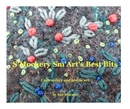for details, see under the "household sewing machines" section.
I am really very pleased with it. It is a very basic model, encased in a modified sewing machine body. Not as pretty as the Babylock or Janome but I figure it's not a sewing machine, so it doesn't matter. The one critisicm I would have is there is no light switch - the machine is on, the light is on and I am quite sensitive to flicker. It is an eight needle punch machine and uses individual needles, so you can replace a broken one, or take some out to suit your project (I haven't tried this yet). There are no frills, no instruction manual, no project book but in the accessory are allen keys for the needles, a brush for cleaning, a small pair of pliers for holding and straightening needles and best of all, some spare grub screws for the needle head (I have lost so many of those from the light covers of sewing machines). Although there is no instruction manual, the distributors have issued an instruction sheet. One thing that isn't made clear is that the presser foot lever is only engaged when the foot pressure is at the factory setting, and that is a very small adjustment. I was confused by this at first, and a little worried, but I soon found I preferred to manually adjust the pressure, and once you get into the swing of it, as for fme, you don't need to use the foot at all! Delivery was excellent, I ordered the machine on Tuesday and I was using it Thursday afternoon. For the price - I reckon its an excellent buy
Here's what I've done with it so far:
Torn strips of muslin (calico, scrim), some dyed some plain, roughly stitched together. Wool tops (roving) laid on top, then worked over with the embellisher. The muslin makes a loopy effect, rather like cable fme stitch. (I also did a piece of this muslin with hot water dissolvable as a stabiliser and silk tops on the surface, see later in this post.)
Cotton and silk cocoon waste, with cold water soluble as a stabiliser. Washed out and dried. This is like cotton/silk paper. Because it was made with waste, there are some seeds and husks.
Cotton and silk cocoon waste neeedle felted on the embellisher without any stabiliser. Worked fine. The embellisher makes a highly textured surface on the top side, and a felty, fluffy surface underneath. I exploited this by turning the piece over and embellishing lines to make a striped pattern on the textured top.
Finally, I used some more muslin strips. I embellished the strips onto a piece of hot water soluble fabric with some natural silk tops. Poured boiling water over, rinsed and dried out. Then I added some small scraps of silk. The effect of needling the silk looks just like dense fme. I added a scrap of unravelled silk yarn. Then I tested the machine by needling the whole thing to a piece of craft vilene (pellon). No trouble at all. Final touch was to burn off stray ends at the edges in a candle flame. And there it is, my first fibre postcard made on the embellisher!
(Click on photos for bigger image)






6 comments:
Another one who has succumbed! Is this the first time you have used an Embellisher, they are very good especially the postcard you made.
I saw your wonderful postcard on Flickr and came right over here for the details! Congratulations on your embellisher purchase!!!
I haven't tried embellishing onto Pellon, yet. Must give that a whirl...
Your postcard is lovely.
Thanks everyone. Yep, never touched one before! I think it may be addictive.
Wow this looks like fun....I'm thinking now I can't wait for my birthday to get an embellisher.
Oh, I want an embellisher too! I think it must be perfect for embroiderybackground!
Post a Comment